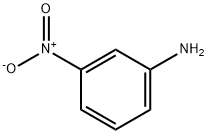M-나이트로아닐린
|
|
M-나이트로아닐린 속성
- 녹는점
- 111-114 °C (lit.)
- 끓는 점
- 306 °C
- 밀도
- 0,901 g/cm3
- 증기압
- 1 mm Hg ( 119 °C)
- 굴절률
- 1.6396 (estimate)
- 인화점
- 196 °C
- 저장 조건
- Store below +30°C.
- 용해도
- 1.25g/L
- 산도 계수 (pKa)
- 2.466(at 25℃)
- 색상 색인 번호
- 37030
- 물리적 상태
- 결정, 결정질 분말 및/또는 덩어리
- Specific Gravity
- 0.901
- 색상
- 노란색에서 황토색 노란색에서 주황색까지
- 수용성
- 1.25g/L
- Merck
- 14,6581
- BRN
- 636962
- Henry's Law Constant
- 1.93 x 10-5 atm?m3/mol at 25 °C (approximate - calculated from water solubility and vapor pressure)
- CAS 데이터베이스
- 99-09-2(CAS DataBase Reference)
안전
- 위험 및 안전 성명
- 위험 및 사전주의 사항 (GHS)
| 위험품 표기 | T | ||
|---|---|---|---|
| 위험 카페고리 넘버 | 23/24/25-33-52/53 | ||
| 안전지침서 | 28-36/37-45-61-28A | ||
| 유엔번호(UN No.) | UN 1661 6.1/PG 2 | ||
| WGK 독일 | 2 | ||
| RTECS 번호 | BY6825000 | ||
| F 고인화성물질 | 8 | ||
| 자연 발화 온도 | 521℃ | ||
| TSCA | Yes | ||
| 위험 등급 | 6.1 | ||
| 포장분류 | II | ||
| HS 번호 | 29214210 | ||
| 유해 물질 데이터 | 99-09-2(Hazardous Substances Data) | ||
| 독성 | Acute LD50 for guinea pigs 450 mg/kg, mice 308 mg/kg, quail 562 mg/kg, rats 535 mg/kg (quoted, RTECS, 1985). | ||
| 기존화학 물질 | KE-25963 |
M-나이트로아닐린 C화학적 특성, 용도, 생산
화학적 성질
3-Nitroaniline is a ochre-yellow to orange crystalline powder, crystallizes as yellow needles from water. It is moderately soluble in organic solvents and sparingly soluble in water (0.11 %).물리적 성질
Yellow, rhombic crystals or powder. Finely dispersered particles form explosive mixtures. Combustible.용도
Dyestuff intermediate. Acetylation of 3-nitroaniline followed by reduction gives 3-aminoacetanilide. Diazotization, followed by reduction of the diazosulfonate with ammonium bisulfite and subsequent hydrolysis, gives (3-nitrophenyl) hydrazine; an intermediate in the production of pyrazolone azo coupling components. 3-Nitroaniline is used as a diazo component (Fast Orange R Base) in azo dyes (e.g., C.I. Disperse Yellow 5 and C.I. Acid Orange 18).제조 방법
M-nitroaniline partial reduction.생산 방법
1,3-Dinitrobenzene is added to warm water containing magnesium sulfate. An aqueous solution of sodium hydrogen sulfide (6 molar equivalents) is added gradually to the vigorously stirred emulsion, and reduction is completed by heating to 90 ℃. The 3-nitroaniline produced solidifies on cooling and is separated by filtration.일반 설명
Yellow needles or yellow powder.공기와 물의 반응
Insoluble in water.반응 프로필
Thermal stability of 3-Nitroaniline is reduced by various impurities. 3-Nitroaniline may be sensitive to prolonged exposure to light. 3-Nitroaniline may react explosively with ethylene oxide at 266° F. 3-Nitroaniline is incompatible with acids (nitric, sulfuric), acid chlorides, acid anhydrides, chloroformates and strong oxidizing agents. . Unstable when heated.위험도
Moderate fire risk. Toxic when absorbed by skin.화재위험
Flash point data for 3-Nitroaniline are not available; however, 3-Nitroaniline is probably combustible.환경귀착
Biological. A bacterial culture isolated from the Oconee River in North Georgia degraded 3- nitroaniline to the intermediate 4-nitrocatechol (Paris and Wolfe, 1987). A Pseudomonas sp. strain P6, isolated from a Matapeake silt loam, did not grow on 3-nitroaniline as the sole source of carbon. However, in the presence of 4-nitroaniline, all of the applied 3-nitroaniline metabolized completely to carbon dioxide (Zeyer and Kearney, 1983). In the presence of suspended natural populations from unpolluted aquatic systems, the second-order microbial transformation rate constant determined in the laboratory was reported to be 4.6 ± 0.1 x 10-13 L/organism?h (Steen, 1991).In activated sludge inoculum, following a 20-d adaptation period, no degradation was observed (Pitter, 1976).
Chemical/Physical. Reacts with acids forming water soluble salts.
Purification Methods
Purify it as for o-nitroaniline. Warning: it is absorbed through the skin. [Beilstein 12 IV 1589.]M-나이트로아닐린 준비 용품 및 원자재
원자재
유황
황화 칼슘
황화나트륨
아황산나트륨
SODIUM TETRASULFIDE
질산
나이트로벤젠
황산
M-디니트로벤젠
3-Bromonitrobenzene
3-nitrophenyl azide
3-Aminobenzeneboronic acid
M-나이트로아닐린
준비 용품
1-(3-NITROPHENYL)-PIPERAZINE
4-hydroxy-1-methyl-3-[(3-nitrophenyl)azo]-2-quinolone
플로로아닐린
3-NITROBIPHENYL
3'-아미노아세트아닐리드
3-Nitrophenol
Disperse Red 74
알리자린 옐로우 GG
Disperse Red S-2GFL
3-Hydroxy-N-(3-nitrophenyl)-2-naphthalenecarboxamide
5-Aminoquinoline
N-(3-Aminophenyl)methanesulfamide
3'-NITROACETANILIDE
3-브로모아닐린
디플르오르벤젠(1,3-)
1,7-PHENANTHROLINE
2,7-Naphthalenedisulfonicacid, 3-hydroxy-4-[2-(3-nitrophenyl)diazenyl]-, sodium salt (1:2)
DISPERSE YELLOW 5








